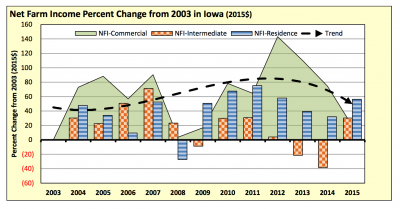Government Executive's Eric Katz reported Tuesday that "the Trump administration is planning to severely scale back or outright eliminate funding for many programs across the Agriculture Department, according to White…
The Importance of the Non-Farm Rural Economy to Farm Household Income
Background: Type of Farm- Net Farm Income Variation
A recent study (“Income Trends for Iowa Farms and Farm Families 2003-2015“) by David Peters, associate professor and extension rural sociologist with Iowa State University, summarized current trends in farm income by type of farm operation and pointed to more specific issues regarding the importance of non-farm income to the financial picture of farm households.
The report began with some basic definitions of farms, based on gross cash farm income (GCGI), and included the following summary table:

Dr. Peters noted that, “Despite accounting for only 24.3 percent of farms in Iowa, commercial farms operated most of the farmland acres (66.6 percent or about 1,000 acres per farm) and generated most of the agricultural sales (79.9 percent) in the state. These farms drive the production agriculture sector in Iowa. Intermediate farms are worked by owner-operator farmers, but have lower sales and smaller acreages. Representing 29.6 percent of all farms statewide, intermediate farms account for 11.8 percent of production value on small acreages (about 220 acres per farm). Residence farms are the most common in Iowa, accounting for 46.1 percent of all farms. However, farming is not the primary occupation of these operators; hence they produced only a small amount of sales (8.3 percent) and operated on very small acreages (about 118 acres per farm).”
There has been variability in net income performance among these three different categories of farms in recent years.
The study pointed out that net farm income has dropped the past three years for commercial farms. However, for intermediate farms in Iowa, “incomes have rebounded after several years of stagnation.” And residence farms have experienced only a minor decline in net farm income, “down 1.1 percent from 2012 levels.”

Net Farm Income, A Part of Farm Household Income
With this general background on net farm income in mind, the Iowa State study also turned to the broader issue of farm household income, a variable that provides “a more accurate picture of the financial well-being of farm families.”
“To gain a fuller understanding of the financial condition of farm families, it is instructive to look at farm household/family incomes. Most farm management decisions are made with respect to the household, taking stock of farm and off-farm incomes earned by all members of the household,” the study said.
Dr. Peters explained that, “Residence farms had high household incomes ($115,941 in 2015) due to well-paid off-farm work. Since residence farms were operated by someone whose primary job is not farming, earnings off- the-farm ($102,614) accounted for 88.5 percent of the household’s income, with the small remainder coming from farm sources ($13,372).”
With respect to intermediate farm families, the study pointed out that, “Despite farming being the major occupation of the operator, off-farm earnings were the major source of income for intermediate farm families.
These farm households brought home $83,138 in income from all sources in 2015, yet 66.2 percent of that income was from off-farm activities.
“The average off-farm income was $55,068, providing a major boost to a rather small farm income of $28,070. After seeing their incomes rise in 2013 (25.7 percent) and 2014 (16.4 percent), intermediate farm families saw incomes shrink by 2.9 percent in 2015. The drop was caused by sharp declines in off-farm earnings that could not be offset by strong growth in farm income, since the farm portion is small. Non-farm earnings tend to fall as farm income rises, and vice versa, suggesting that off-farm work is temporarily used to cover farm losses. It is clear that intermediate farm households rely heavily on off-farm work to supplement rather low farm earnings.”
Turning to mid-size farm households (a subset of commercial farms, see definition box above), last month’s study explained that:
Mid-size farm households earned $250,562 in 2015, with over two-fifths (44.2 percent) of it from off-farm sources.
“Farm family incomes have remained relatively stable, but off-farm work has risen. Household income fell by 7.0 percent in 2014 as farm earnings contracted with no gain in off-farm work to make up the difference. By 2015 the situation was reversed as household income grew 23.2 percent, driven by sizable growth in off-farm earnings, but with no growth in farm income.”

Recall also that updated information in November from USDA’s Economic Research Service (ERS) pointed out that, “Median total income for farm households increased each year from 2010 to 2014 before declining slightly in 2015. Broad increases in farm household income largely reflect greater income from off-farm sources, where the majority of farm households earn most of their income.”

Near the conclusion of the Iowa State study, Dr. Peters pointed out that, “A struggling farm economy only highlights the need for non-farm employment opportunities for all farm families. Middle-skill and middle-wage jobs are the key underpinnings of a strong non-farm rural economy in Iowa. These include traditional ‘blue collar’ industries like manufacturing, construction, transportation, and utilities; but also some ‘white collar’ sectors like healthcare and education that employ many middle-skill professionals. Economic development programs should focus on the recruitment, expansion, and retention of these firms; and workforce programs should target training to jobs in these industries. The fortunes of both smaller family farms and mid-size commercial ones are closely linked to the non-farm rural economy, making rural economic development a priority for the state.”
As the Farm Bill debate unfolds, the importance of off-farm income and the broader rural economic environment should not be overlooked when considering the financial well-being of farm households.





